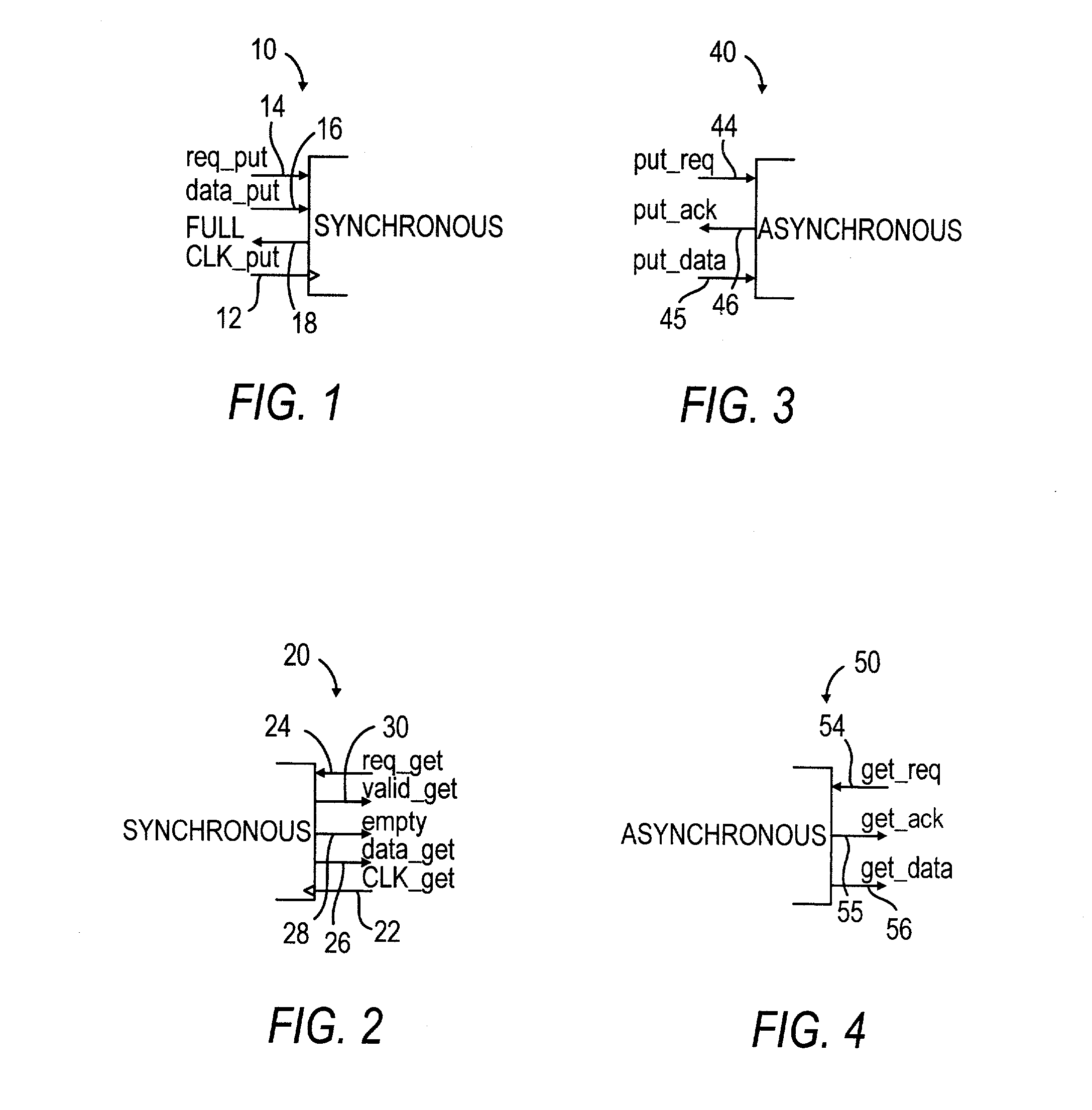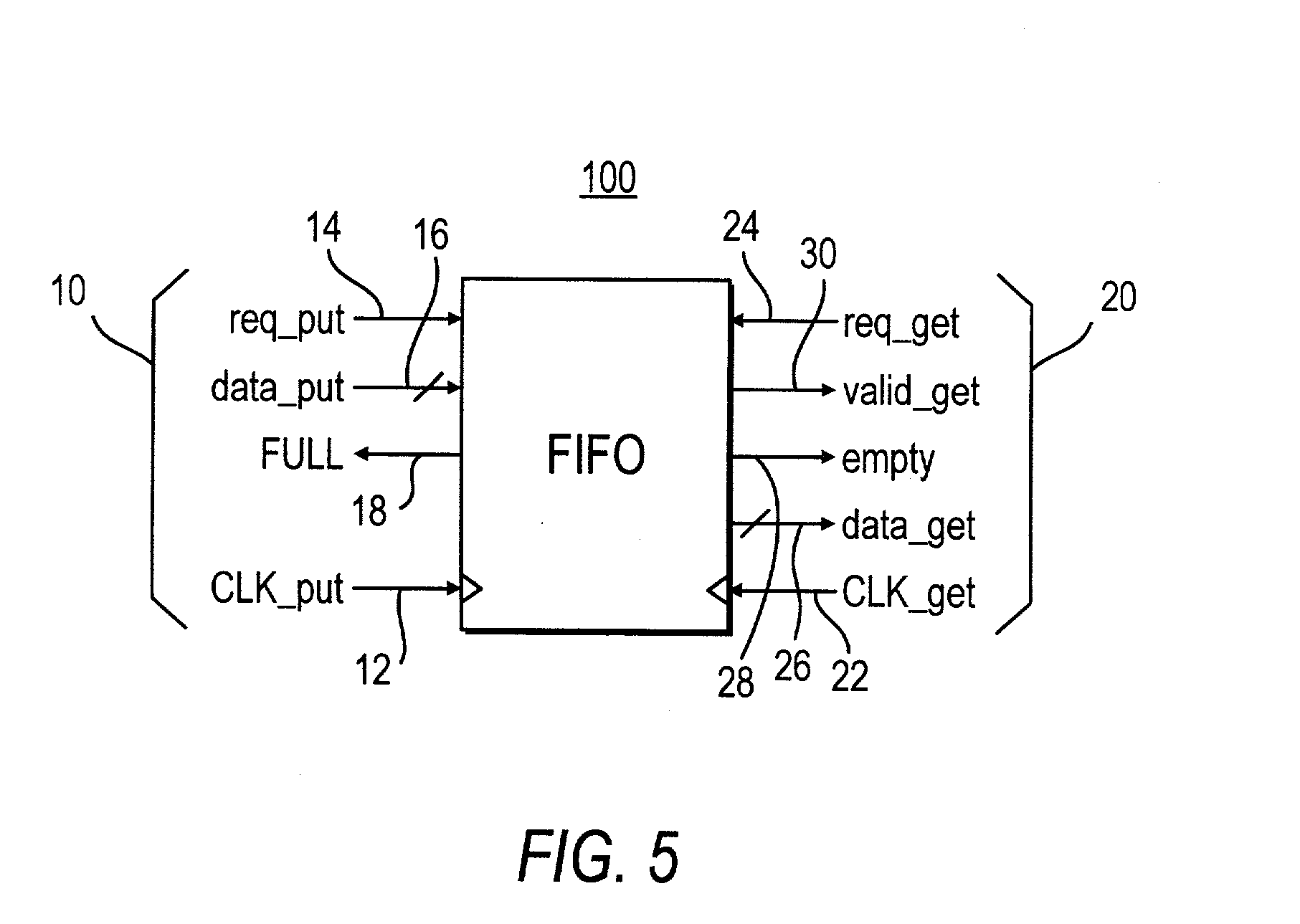Low latency FIFO circuits for mixed asynchronous and synchronous systems
a technology of mixed asynchronous and synchronous systems, applied in the field of low latency fifo, can solve the problems of long delays in communication between systems, few adequate solutions, and complex interface between these domains
- Summary
- Abstract
- Description
- Claims
- Application Information
AI Technical Summary
Benefits of technology
Problems solved by technology
Method used
Image
Examples
first embodiment
[0112] Cell 170a in accordance with the first embodiment is also shown in FIG. 16. The behavior of cell 170a may be illustrated by tracing a put operation and then a get operation through the cell 170a. Initially, the cell 170a starts in an empty state (i.e., e_i=1 and f_i=0) and without any tokens. The cell 170a waits to receive the put token on put token input 190 (ptokn_in=1) from the right cell on the positive edge of sender clock signal 12 (CLK_put), and waits for the sender to place a valid data item on the put data bus 16 (data_put). A valid data item is indicated to all cells by the put enable signal 180 (en_put=1), which is the output of the put controller 176 (See FIG. 6).
[0113] When there is valid data and the cell has obtained the put token (i.e., AND 181), the cell 170a performs three actions: (1) it enables the register 191 (REG) to latch the data item and also the put request signal 14 (req_put); (2) it indicates that the cell 170a has a valid data item (asynchronousl...
second embodiment
[0132] The interfaces of the FIFO circuit i.e., asynch-synch FIFO circuit 200, were described above with respect to FIG. 7. They are obtained by using the asynchronous put interface 40 (FIG. 3) and the synchronous get interface 20 (FIG. 2). The FIFO circuit protocol on these interfaces was described with respect to FIGS. 12-13, and the architecture of the FIFO circuit 200 was shown in FIGS. 7-8. With specific reference to FIG. 8, FIFO circuit 200 uses a number of components which have been described above, i.e., interface components such as the get controller 278, empty detector 74 and synchronous cell components. The remaining components in cells 270a-d, i.e., the asynchronous put component, and the data validity controller are described herein with respect to FIGS. 22-23.
[0133] The synchronous part of cell 270a shown in FIG. 23 is identical to the corresponding components of cell 170a (FIG. 16) in FIFO circuit 100 (FIG. 6). The asynchronous part of cell 270a is decomposed into se...
example
[0198] EXAMPLE
[0199] In order to evaluate the performance of the various FIFO circuit designs, Each of the exemplary FIFO circuit 100, 200, 300, 500, 600, and 700 were simulated. Each FIFO circuit was simulated using both commercial and academic tools. The designs were built using both library and custom circuits, and were simulated using Cadence HSPICE. The Burst-Mode controllers were synthesized using Minimalist (Minimalist is described in greater detail in R. Fuhrer et al., "MINIMALIST: An Environment for Synthesis, Verification and Testability of Burst-Mode Asynchronous Machines," CUCS-020-99, 1999, which is incorporated by reference in its entirety herein.) and the Petri-Net controllers were synthesized using Petrify (Petrify is described in greater detail in J. Cortadella et al., "Petrify: A Tool for Manipulating Concurrent Specifications and Synthesis of Asynchronous Controllers," IEICE Transactions on Information and Systems, Vol. E80-D, Number 3, pp. 315-325, March 1997, wh...
PUM
 Login to View More
Login to View More Abstract
Description
Claims
Application Information
 Login to View More
Login to View More - R&D
- Intellectual Property
- Life Sciences
- Materials
- Tech Scout
- Unparalleled Data Quality
- Higher Quality Content
- 60% Fewer Hallucinations
Browse by: Latest US Patents, China's latest patents, Technical Efficacy Thesaurus, Application Domain, Technology Topic, Popular Technical Reports.
© 2025 PatSnap. All rights reserved.Legal|Privacy policy|Modern Slavery Act Transparency Statement|Sitemap|About US| Contact US: help@patsnap.com



